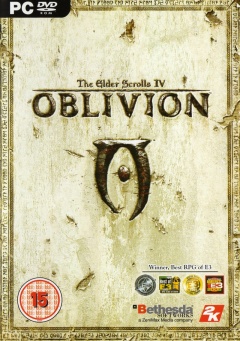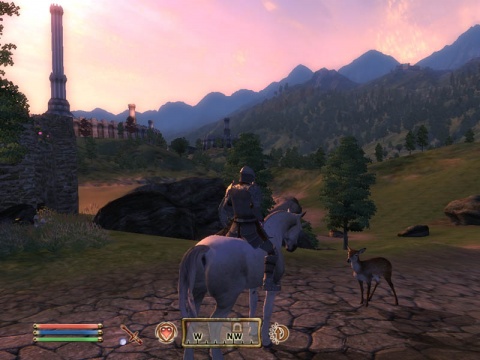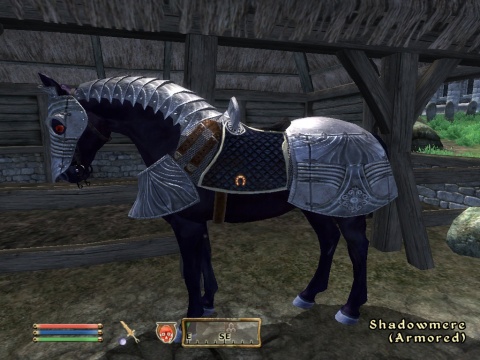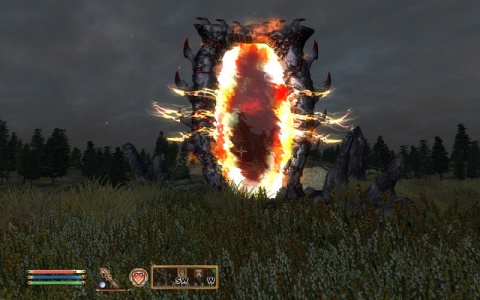The Elder Scrolls IV: Oblivion
| The Elder Scrolls IV: Oblivion | |
|---|---|
 |
|
| Platforms | Windows, Xbox 360, PlayStation 3 |
| Genre | Epic predecessor |
| Score | 9  |
| Buy from Amazon | |
It's been awhile since I've written anything for First Hour; between marriage, work, college and some gaming, there isn't much time for writing. But this is a special month, a month that I've been looking forward to for a long time.
Last Friday, November 11th, 2011, was the release of Skyrim, possibly the most anticipated game of this year, right next to Call of Duty: Modern Warfare 3. So today, I am reviewing The Elder Scrolls IV: Oblivion.
I had played Morrowind religiously for roughly six months. In fact, it was the second game I bought for the original Xbox. It was an incredible experience, to face a giant world with so many dangers, and so much customizing, I became massively invested. I played at least six hours a day during the school week and twelve during Saturday and Sunday.
So after years of playing The Elder Scrolls III: Morrowind, my sophomore self was surprised to see Oblivion on the cover of a Game Informer in the high school library. I was in awe at the graphics, the hope for a better combat system. But the most amazing thing, that reportedly happened at Bethesda as well, was seeing what was once thought impossible: they had forests. Real, bustling forests with bushes and shrubbery and groups of trees.
I couldn't stop thinking about it, and then it was finally released. I was amazed at the game. Now, let's take and nice overview about some of the feelings and thoughts of the game before and after Oblivion's release.
Controversy
There were a couple of controversies (if you can call them that) around Oblivion. One was after the games initial release. The ESRB had originally given The Elder Scrolls IV: Oblivion a T (13 years of age or older) but then later changed it to M (17 years of age or older) due to an exploit on the PC port of the game allowing modders to see the bare breasts of the main character. This event was used by anti-game groups to claim that the ESRB was incapable of its intended job. No progress on their side was gained, as Bethesda explained that they “...can't control and don't condone the actions of anyone who alters the game so that it displays material that may be considered offensive.” Most reasonable people understood, and even most unreasonable people felt there were more important issues, like terrorism, to criticize.
The one big controversy existed before the games release, and that was whether or not the average computer would even be able to run the game, and with good reason. With images of the game all over the internet, most PC gamers had cause for concern.
At the time, the Geforce 7 Series and ATI X1000 series were about to fade out that year, but people were still worried and with no real new CPU architecture coming anytime soon, there was little comfort for them.
The AMD Athlon 64 series (Athlon 64, X2, FX series) was still the king of consumer processors. My rig, at the time, was an average machine: 1GB DDR RAM, AMD Athlon 64 X2 2.4 GHz and a Nvidia Geforce 6600GT. I was shaking in my boots, because there was no possible way I could hope to afford a new GPU as I was still in the AGP slot phase.
This was when I checked on Gamespot.com and saw that they had “Can you run it?” on their website, which was essentially a program that would compare your hardware with the requirements. PC Gamers everywhere released a sigh of relief heard 'round the world when they discovered that they could, indeed, run Oblivion. However, no one I knew could play it on the highest settings.
Gameplay
The game plays much like its predecessor, with some tweaks here and there. The biggest thing I cared about was the combat being far more mainstream and enhanced. In Morrowind, you simply swing your weapon as fast as possible – everything else is done for you. You attack in three directions that are somewhat influenced by the way you’re moving. However, there is an option in the game to always swing the most powerful way for that particular type of weapon. The blocking itself is also simply a stat, not controlled by you. It’s almost as if combat is not the main part of the game, and it’s true. The story takes center stage in this game.
In contrast, Oblivion allows for far more control in combat. As you level up your skills in the area of your specialty (blade/blunt/hand to hand) you will be able to perform more complex attacks. It still isn’t extremely involved, as all of your special attacks are performed by moving in a certain direction and holding the attack button (performing a power attack.)
The difference in these two is that the combat in Morrowind is really a necessity. A lot of combat you can avoid, but it still sometimes happens, and when it does you dish out death easily or die quickly. It’s usually that simple, but it makes the story shine.
In Oblivion, the combat is more balanced and more entertaining, but the story just doesn’t deliver like in its predecessor.
Leveling in Oblivion is simpler than in the previous game. Morrowind had 27 skills, while Oblivion had 21. You may say, "but wait, that’s only six fewer!" and that’s correct, mathematicians, but the difference is monstrous. In Morrowind, you had skills in long blade, short blade, axe and blunt weapon. In Oblivion, you have Blade, Blunt and hand to hand. This makes it much easier to level up. It helps avoid making you grind skills just so you can use that special great axe you found.
But, the truth in most of this is that you lose a lot of the customization that you had in Morrowind for the sake of simplicity. But overall, I would say this is was a good choice. The game is still open, still customizable but not nearly as confusing. While some people like downloading and printing hundreds of pages of walkthroughs and skill suggestions, crafting recipes and such, I believe a lot of it is unnecessary for me.
There are a couple of things I really didn’t agree with, and I’ll explain them simply:
The first gripe: The items and monsters level with you – you basically never fight anything beyond your ability. This leveling-with-you deal also includes weapons and armor that level with you, aka, at level 1, you’re getting iron weapons, levels 2-3, steel. Levels 4-5, silver, etc.
In Morrowind, if you go somewhere you’re not supposed to, you’re screwed. This was exciting. Those occasional deaths because you’re fighting something levels above you gives you an eagerness to go back. What treasures lay in store for you? In Oblivion, they hold your hand. The only way to counteract this is to throw up the difficulty, but then everything is harder, rather than having those special places that you’re just not yet ready to face.
The second gripe: You are able to fast travel anywhere that you have visited before, and to the main cities without visiting them once. This means that most of the time, once you’ve visited an important place once, you can simply click the location on your map and just go there. Some people like this, and it does make the game easier to play, but it’s also kind of boring to just be able to go places. I guess, in a way, the game simply doesn’t force you to spend hours walking, and that’s not so bad, however, I didn’t find myself really complaining in Oblivion.
Graphics
Damn. The graphics in this game are still fantastic. Not exactly the most beautiful, but I still know a lot of people that struggle running this at max settings on the PC. The game’s open world is what makes this game difficult to run. You almost never hit a loading screen, simply because your machine is pre-rendering it all.
The forest, oh man! The forests are awesome. It’s so fantastic, and so immense that I think this might have been the biggest impression on me. The fact that this world was more complete than any game before it was amazing, but what hits home is that it’s still more complex than the majority of games today.
Story
I don’t want to delve too deeply into this part, because I don’t want to risk spoiling it, and it’s hard for me to really explain it. Suffice it to say that the story isn’t anything to write home about. It’s fine, but it’s not fantastic. You’ll play through it; maybe a few surprising twists and turns will barely make you stumble. But overall, this is not the most important part of the game. Considering that I’ve put hundreds of hours into this game, with multiple characters, I’ve only ever completed the story line once. I played through the story of Morrowind every time I created a new character. A bit of a difference, I’d say.
Music: I won’t harp – oh, nevermind. The music is fantastic, and fits the game perfectly; it’s brighter, and even “epic.” As soon as you click “new game” you will be enlightened almost immediately why it is so appropriate.
Overall: 9
Overall, I would say this game’s only weakness is its story, but for me, I didn’t notice all that much. There’s simply so much game to be experienced in Oblivion, so much to be explored, that a few of the less complicated parts make the game better and more mainstream.
This game has so much nostalgia for me, and so much anticipation that I sometimes wish that I could go back and experience that joy again. But at the time of this writing (Thursday night, 11/10/11) I am just waiting a single hour more before I pick up The Elder Scrolls V: Skyrim.
As much as I wish I could go back sometimes, like replaying Oblivion for the first time, or Diablo II, or any of those other games that really hit home with me, I understand that there will always be more groundbreaking games, computer upgrades, consoles and more!
Oblivion is a game, with or without nostalgia, you’ll love. So get it for $15-$20 (the game of the year edition) and get playing!



